The Victor Sine Clade Funeral Medal
Posted on 12/12/2017
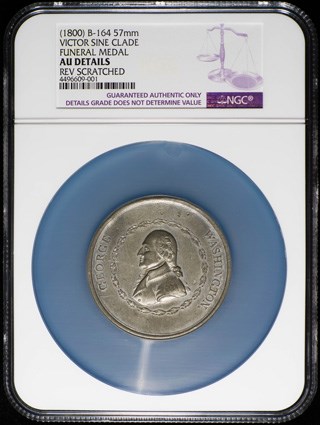 |
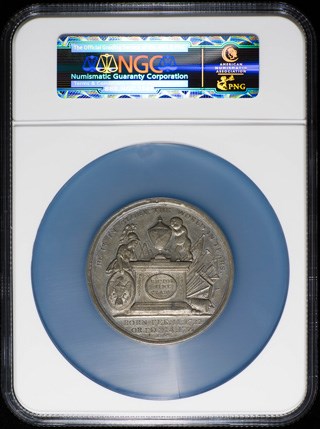 |
|
(1800) B-164 57mm Victor Sine Clade Funeral Medal, NGC AU Details Click images to enlarge. |
|
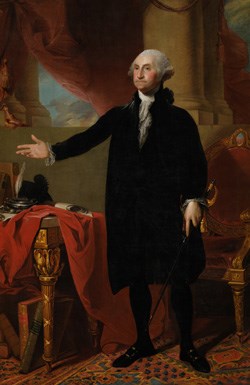 |
|
| The Lansdowne Portrait (Oil-on-canvas) of George Washington by Gilbert Stuart, April 12, 1796 |
|
On December 14, 1799, George Washington passed away at Mount Vernon, just two years after retiring as President of the United States. Upon his death, any hint of criticism from his presidency faded as the nation pondered his heroism and legacy. Major General Henry Lee, Washington’s protégé and close friend, prepared a hastily written eulogy which contained the phrase, “First in war, first in peace, and first in the hearts of his countrymen.” This phrase would be recited in schools for decades following, and become the motto engraved on many numismatic pieces bearing Washington’s portrait. Ironically, Lee would father Robert E. Lee, a man who would nearly succeed in breaking apart the union that his father and Washington had fought to establish.
While the American people were deeply moved over Washington’s passing, mementos and Washington-related items became extremely popular. Among the many funeral processions organized throughout the nation, two of the largest and most publicized were held in Boston, one on January 9 (according to Musante), and another on February 11, 1800. A 69-day public mourning period culminated on February 22, Washington’s birthday.
The smaller medals were advertised as early as January 3. Of the many memorial items advertised for sale was the Victor Sine Clade funeral medal. The medal was advertised in the Massachusetts Mercury on February 11, 1800, the same day as the funeral procession conducted by the Freemasons. Like the other medals, it was intended to be worn at the event. Musante’s Medallic Washington notes that the piece has strong Masonic association, as it was offered for sale at Masonic locations.
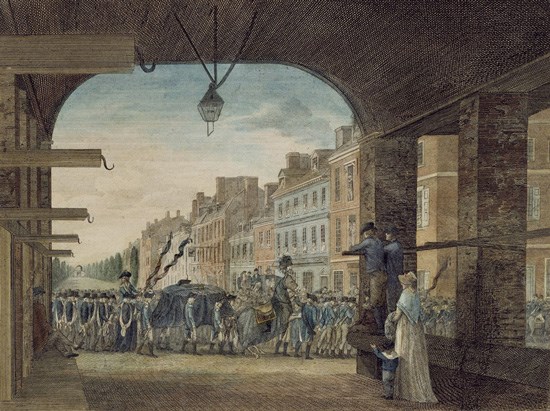 |
|
| A view of one of Wasington's funeral processions on High Street in Philadelphia on December 26, 1799 |
|
The Victor Sine Clade funeral medal is attributed as Baker-164 and listed in Musante’s Medallic Washington as GW-76. The obverse is a well-executed bust of Washington in military attire inside a laurel wreath. The legend on the reverse is the same as on the obverse of the smaller funeral urn medal: “HE IS IN GLORY, THE WORLD IN TEARS.” The phrase on the pedestal “VICTOR SINE CLADE” originates from the Odes, a collection of Latin lyric poems by Horace. The poem describes Tiberius’s victory over the Rhaeti, and the phrase means “victor without a rout,” or “victorious without suffering loss.”
The dies were cut by Jacob Perkins of Newburyport, MA, an extremely talented bank note engraver, and the designs were supplied by Dudley A. Tyng, a well-respected lawyer who was appointed by Washington himself in 1795 to be the first customs collector at Newburyport. Perkins is also responsible for producing the smaller funeral medals, which came in many varieties and were widely distributed. They were well-advertised by him, with one ad claiming that as many as 5,000 could be struck in a day. The larger medal cost more to produce, and only a handful survive today. All of the funeral medals were struck in early 1800.
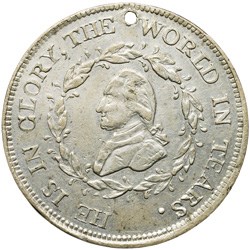 |
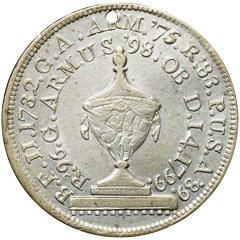 |
| An example of one of the more common smaller funeral medals, also produced by Jacob Perkins. This "Funeral Urn" medal is around 30 mm in diameter and graded NGC AU 55 Click images to enlarge |
|
The Victor Sine Clade medal is noted among the rarest of Washington medals, and the piece is missing from many prominent collections because it is extremely difficult to acquire, especially in respectable condition. Many of the surviving examples are in poor shape. The wear and abuse these medals normally see resemble that of awarded Indian peace medals. In the same way, most were holed for suspension, as in the case of the smaller funeral medals. Nearly all were stuck in white metal, and Neil Musante notes that this medal was recently discovered in silver. Baker documents that imitations cast in lead were “numerous”, but it is doubtful if these exist today, and it is certain that none of the originals were made in lead. It is likely he confused these with heavily worn white metal pieces. A metallurgic analysis of the example NGC-certified medal revealed a composition of about 90% tin and 10% lead.
To see the video of this numismatic rarity, click here.
Because white metal is soft, most have rim bumps, and appear to have been affected in some way that prevents a numerical grade from being assigned. Therefore, an NGC Details holder should not deter a buyer, nor detract from collector enthusiasm. These medals were often proudly worn by their owners in the years following the funeral. Baker claims that there are only 2 or 3 known in decent condition; however, there are probably at least a dozen in existence, though they are particularly hard to find in higher grades. A premiere example sold in Part II of Stack’s John J. Ford Jr. sale in May of 2004, was labeled “The finest this cataloguer has ever seen and quite likely the finest known.” This recently submitted specimen, however, appears to have even sharper detail, albeit a few more marks.
Remarkably, two other examples were offered in the Ford sale, both holed. Other noteworthy specimens include the LaRiviere example (plated in Baker), sold by Stack's in 1999, and a well-worn piece sold in a March, 2014 Stack's sale. In 2016, a VF details specimen certified by NGC sold in a Heritage Long Beach Auction. Another higher grade and unholed example is plated in Musante. The LaRiviere auction write-up mentions others residing in collections are of lower quality.
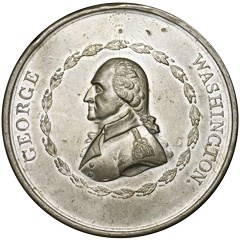 |
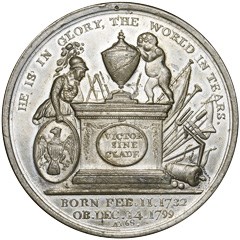 |
| The Victor Sine Clade medal submitted by Colonial Trading Co of Boston, Massachusetts Click images to enlarge |
|
The medal shown here was acquired about 15 years ago by Colonial Trading Company of Boston, MA, which is owned and operated by Lou Chorney. Chorney is collaborating with Stanley Chu, a volunteer District Representative of the American Numismatic Association for the Massachusetts area, to open a money museum above the store to bring numismatic awareness to the general public. The museum will have an “Early American Money” display, where this medal will likely be exhibited for a time. The Victor Sine Clade medal is a most wonderfully executed slice of history, and it would be a highlight to grace any cabinet of Washington related items.
Sources:
- http://www.mountvernon.org/digital-encyclopedia/article/first-in-war-first-in-peace-and-first-in-the-hearts-of-his-countrymen/
- http://explorepahistory.com/hmarker.php?markerId=1-A-289
- https://www.coinworld.com/news/us-coins/2013/12/remembering-dec-14-1799.all.html
- http://www.ushistory.org/birch/plates/images/big_pics/plate_11.jpg
- media.stacksbowers.com/VirtualCatalogs/2014/Stacks-Bowers-Galleries/sbg-mar2014-balt-coin-sess-3-LR.pdf
- The Oxford Handbook of Neo-Latin, pg 44
Stay Informed
Want news like this delivered to your inbox once a month? Subscribe to the free NGC eNewsletter today!
Add Coin
Join NGC for free to add coins, track your collection and participate in the NGC Registry. Learn more >
